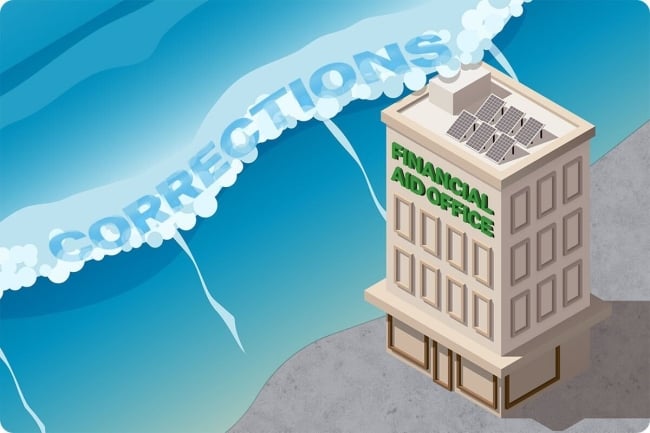You have /5 articles left.
Sign up for a free account or log in.

This year’s wave of FAFSA corrections is so much larger than usual that it threatens to overwhelm financial aid offices.
Photo illustration by Justin Morrison/Inside Higher Ed | Macrovector/iStock/Getty Images
Up to 16 percent of the 7 million Free Application for Federal Student Aid (FASFA) forms submitted so far include student errors and require corrections, the Education Department announced last Wednesday—far more than usual.
“We’re seeing much higher error rates from students,” said Jon Boeckenstedt, vice provost for enrollment management at Oregon State University. Though he didn’t have exact numbers, he said it seemed to be 3 to 4 times as many as in previous years.
Bill DeBaun, senior director of data and strategic initiatives at the National College Attainment Network, did have numbers. In a typical year, he said, FAFSA submission rates are about 7 percent higher than completion rates—a gap made up largely of forms with errors. This year, the gap is 30 percent.
“We need to turn those submissions into completions,” he said. “It would be tragic to lose students so far along in this process because we couldn’t get them over the finish line.”
Jon Fansmith, senior vice president of government relations for the American Council on Education, said the volume of corrections bodes poorly for low-income students in particular.
“Mistakes are more likely from low-income students who do not have someone to walk them through the process,” he said. “But even most counselors are in the dark because this form is new. It’s a recipe for disaster.”
Student errors aren’t the only mistakes gumming up the works. The past few weeks have also brought to light several calculation errors from the department, meaning nearly 20 percent of all Institutional Student Information Records, or ISIRs, will need to be reprocessed before accurate aid information can be sent to students.
Karen McCarthy, vice president of public policy and federal relations at the National Association of Student Financial Aid Administrators, said that together, the student corrections and department-level miscalculations have made an already challenging financial aid year far more complicated.
“They all kind of get added together into the category of ‘problem FAFSAs’ that we cannot issue an aid offer for,” she said. “Most years, the vast majority of ISIRs come in clear, they don’t need more work … This year, the ISIRs are coming back funkier, and so the process is more time-intensive. And that’s time we just don’t have.”
Awaiting the Flood
An Education Department spokesperson told Inside Higher Ed that most of the corrections should take students only a few minutes to complete. McCarthy said that seemed true, and most of the errors she’s tracked are simple ones, such as missing signatures or incomplete parental consent pages.
She added that one of the new questions, number 8 on the form, seems to have stymied more applicants than any other. It asks students if they want to apply for a “direct unsubsidized loan,” but in obtuse language littered with double negatives.
“Are the student’s parents unwilling to provide their information, but the student doesn’t have an unusual circumstance that prevents them from contacting or obtaining their parents’ information?” the question reads, according to a screenshot of the form provided to Inside Higher Ed.
“I’m not surprised the rate is higher, just because the process is so different,” McCarthy said.
Still, the sheer volume of corrections isn’t a looming disaster on its own; in a normal year, even a surge in errors would be manageable because they can be addressed almost as soon as the FAFSA is opened, she said. But this year, students weren’t able to make corrections until last week; for months, they’ve just been piling up, flagged for errors but with no immediate avenue for recourse.
“The biggest issue with these higher numbers of rejected FAFSAs is that there were no corrections open, so none of them can be fixed, even those that are relatively minor fixes,” McCarthy said. “Hopefully, now that issues at least on the student side are starting to be resolved, we can get some FAFSAs in the pipeline toward issuing actual aid offers.”
Fansmith worries that any further mistakes could disrupt the final stretch of the FAFSA push.
“Financial aid offices are running a 24-7 operation right now,” he said. “The additional strains from the errors and corrections are significant.”
‘Soft Launch’ 2.0
Students were finally allowed to make corrections to their forms beginning last Thursday. But many who tried were quickly locked out; the ED said the corrections portal was in a trial period, and that functionality would be limited until early this week.
“Students and FAFSA form contributors may be able to see correction availability for very brief periods while we complete testing,” the department said in an announcement on Thursday. “During this testing phase, users attempting to make corrections may experience issues.”
“It worked for a few hours this morning and then went down for the day,” Boeckenstedt said in a call Thursday night.
He added that the experience gave him and other financial aid administrators a sense of déjà vu. When the new FAFSA itself went online in late December, it was also unfinished—the department called it a “soft launch”—and was shut down for maintenance many hours a day.
While he hopes the corrections portal becomes fully operational much sooner, he has his doubts.
“There’s no reason that we should think the Department is going to do this completely accurately the first time out,” he said. “They just haven’t demonstrated that’s the way they’ve been operating.”
Still, he said, it could be worse. The burden on institutions is lighter this year because the department, in response to a flood of requests from colleges and advocacy groups, loosened verification requirements in February, meaning it is asking fewer colleges to review forms for potential inaccuracies in reported income.
But the work of verification has been replaced by the task of dealing with the hike in errors and corrections, and DeBaun said the correction surge could be even more of an access problem than verifications. Because of the whiplash nature of this cycle’s updates, he said, the challenge of turning incorrect forms into completed ones could lead some students to abandon the process, as verification sometimes has in years past.
“Correction melt could be even more pronounced because students are already frustrated, and now they have to actually go back into their forms,” he said.
Still (Re)Processing
The Education Department spokesperson told Inside Higher Ed that the Department is currently beginning to reprocess ISIRs affected by calculation errors, and aims to finish by May 1.
In the meantime, to minimize the impact of the tax calculation errors that ruined hundreds of thousands of ISIRs, the department sent out guidance on how to use original ISIRs to package aid offers. Those ISIRs may be incorrect before reprocessing, but as long as they don’t indicate a decrease in students’ aid, colleges can base their aid packages on them and will not be audited for doing so.
A department spokesperson told Inside Higher Ed that in the majority of cases, colleges working off the original ISIRs will not need to manually adjust the Student Aid Index. But Fansmith said that when they do, it can be a time-consuming process.
“Reprocessing manually is a ton of work,” he said. “Doing that at a small or mid-sized school is maybe feasible. At a large university, the volume is just too high.”
Many colleges are doing it anyway, Fansmith said, so they can get aid offers out the door without waiting for the reprocessed forms to roll in. Boeckenstedt said Oregon State considered this strategy but decided it wasn’t worth it.
“We’re trying to balance speed and accuracy, and right now accuracy is winning out,” he said.
The silver lining from a week of mistakes and announcements of further delays is that colleges know where they stand, McCarthy said. If any thought they could still get aid offers out before May 1 deposit deadlines, they should be more clear-eyed now.
“The bright side is, we’re not flying blind anymore,” McCarthy said. “It’s not all great news, but at least we know what’s on the table. We can move forward from here.”





